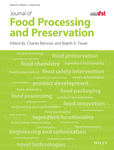Water dynamics of turbot flesh during frying, boiling, and stewing processes and its relationship with color and texture properties: Low-field NMR and MRI studies
Funding information: National Key Research and Development Project, Grant Number: 2016YFD0400404; the National Key Technology Research and Development Program of China during the 12th Five-Year Plan, Grant Number: 2014BAD04B09; the National Key Scientific Instrument and Equipment Development Project of China, Grant Number: 2013YQ17046307; the National Nature Science Foundation of China, Grant Number: 31501561
Abstract
Water dynamics in turbot flesh during frying, boiling and stewing was assessed by nuclear magnetic resonance (NMR) and magnetic resonance imaging (MRI) techniques. Protons associated with different types of water were distinguished by T2 relaxation spectra, and significant differences of water mobility were detected. Principle component analysis revealed a clear discrimination between samples of different cooking methods. MRI provided further visualization of internal information for turbot flesh during cooking. The linear regression analysis demonstrated a strong correlation between the NMR parameter A23 and b* value (R2 = .972) during frying process, A23 and L* (R2 = .963), T22 and b* (R2 = .991) during boiling process, T22 and b* (R2 = .883) during stewing process. Moreover, a good correlation was found between A21 and cohesiveness (R2 = .924) during the frying process, A23 and resilience (R2 = .879) during boiling process, as well as between A23 and chewiness (R2 = .946) during stewing process.
Practical applications
Water mobility and distribution can significantly affect turbot flesh physical and biochemical status leading to change the texture, color, tenderness and taste during cooking process. Therefore, it is very important to develop a fast, nondestructive method to monitor the water dynamics, reduce the cooking time, save energy and visualize the structure change of turbot flesh during cooking. In this study, a rapid and nondestructive NMR and MRI method were developed to analyze the water dynamics of turbot flesh during frying, boiling and stewing for the first time. The water states, distribution and mobility were analyzed by the NMR and MRI. Different cooking methods displayed different water dynamics in turbot flesh, which could be identified when NMR combined with chemometrics principal component analysis. The facile method by using both NMR and MRI for analysis of turbot flesh may have great potential for rapid and nondestructive analysis of other food processing.
CONFLICT OF INTEREST
None.




